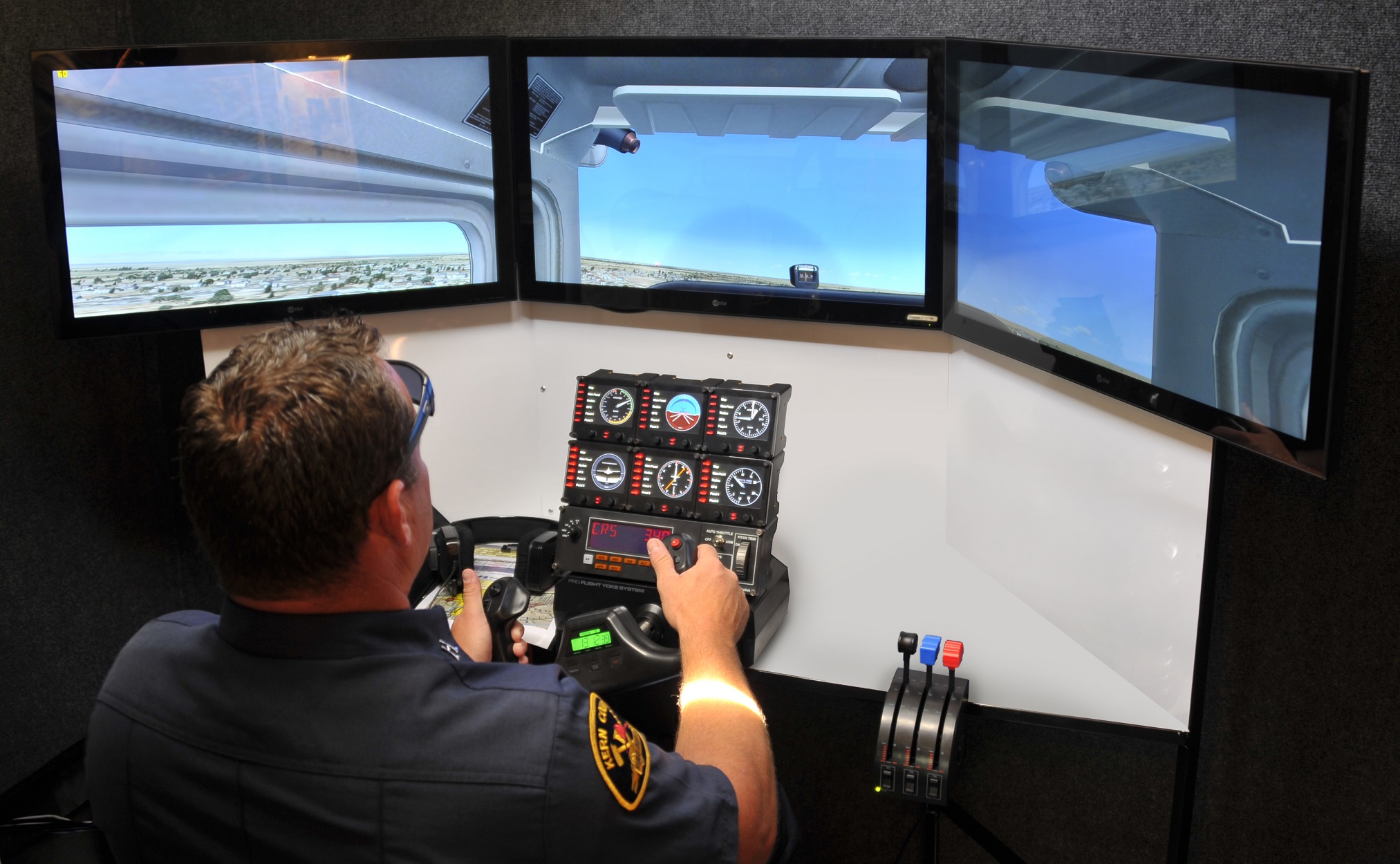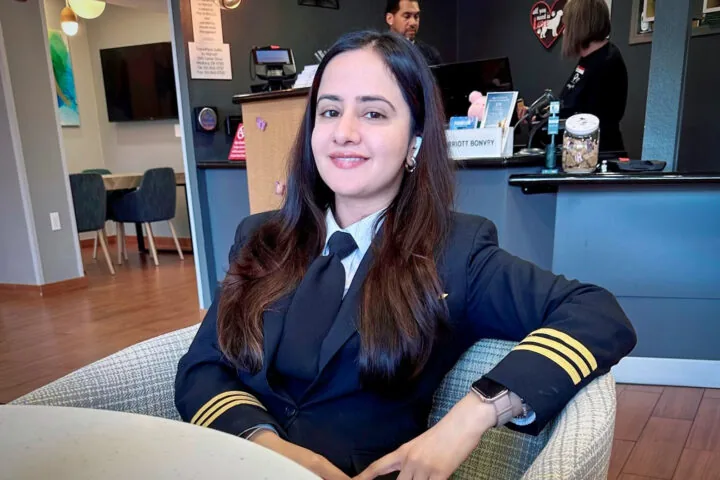Flight simulation is largely how pilots with advanced certificates and ratings prepare to fly new aircraft. CAU offers state of the art flight simulators as a tool for students.
[lwptoc]
The Federal Aviation Administration (FAA) allows some flight training to take place out of the cockpit. “Flying” a simulator, or “flight training device”, has become a staple of flight training as computer technology has become more and more advanced. Full motion simulators provide pilots and student pilots with not only the ability to review certain scenarios in flight, but also the sensation of certain input on the flight controls.
Far more advanced than what you might experience in front of your desktop computer or gaming console, flight simulation helps pilots to rehearse rapid decision making and put “book knowledge” into practice. Less expensive than in-air training, more accessible to schedule, and available no matter the weather, flight simulation is largely how pilots with advanced certificates and ratings prepare to fly new aircraft.
California Aeronautical University’s Suite of Simulators
California Aeronautical University’s simulators offer flight experiences for students at all levels of development. They are all recognized by the FAA as part of the National Simulator Program (NSP.) CAU’s flight flight simulations include:
- Redbird MCX 172 Configuration Dual Control Motion: This simulator is a complement to CAU’s Cessna 172 G1000 Skyhawk training aircraft. This flight training device is excellent for flight students learning to work as a crew. Its dual controls allow not only a flight instructor and student to train, but a pilot learning how to become a certified flight instructor (CFI) can take practice flights without ever leaving the ground. Maneuvers can be easily demonstrated from either seat. The simulator is full-motion, and offers a dual control-loading yoke. Dual rudders are available as well. This means that instructors can quickly assert control of the airplane if necessary, or ascertain how effectively a student is coordinating flight controls. Visuals wrap around the entire field of vision, allowing for a more realistic training environment than a single screen alone.
- Redbird SD 172 Configuration Single Control: The SD’s configuration is ideal for students training for solo or instrument flight, or those who seek proficiency without an instructor’s assistance. The flight training device is enclosed and features a Garmin G-1000 glass cockpit, just like the Cessna 172 G1000 Skyhawk. Unlike the MCX, the SD offers one rudder and one yoke to allow students to rehearse flight control input. Although the SD does not have a motion platform, its full enclosure cockpit allows for a realistic flight training environment. It is FAA approved, and its visuals provide a complete immersion experience.
- Frasca Baron 58P Configuration Twin Dual Control: Flight students working on their multi-engine rating or who seek experience in complex aircraft, such as CAU’s Cessna 172 RD or Beechcraft Baron 55, will find the Frasca flight training device a good match for their simulator needs. It meets FAA standards and includes a fully integrated system of avionics, as well as an instructor station. The shell of the simulator is constructed to match the dimensions of the real aircraft. Like the MCX full motion simulator, it offers dual rudder and dual yoke control. This renders it ideal for an instructor or CFI training situation. Candidates for a multi-engine rating will find that the Frasca simulator replicates the performance and handling a complex airplane.
Safely Manage Risk in a Flight Simulation Environment
Student pilots who are assured in their aeronautical knowledge, but who seek practice and confidence in an actual cockpit, can do well in the “half step” of working in a simulator. Those who fear working with flight control surfaces, or who require practice to coordinate them effectively, can benefit from just one session in a full motion or stationary “sim session.”
Since much of working as a safe pilot is effectively managing work load, doing so first in a simulator environment helps the pilot practice the emotional and psychological effects of working through an in-flight emergency or suddenly deteriorating weather conditions. “Aviating” in a simulator allows flight students to take risks and recover from mistakes. He or she can practice such vital skills as recovering from a stall. In addition, in the event a student becomes overwhelmed in a maneuver or flight simulation scenario, he or she can quickly and easily “back up” and take another pass until the skill is better understood or acquired.
Rehearse In-Cockpit Communication
Speaking on the radio with other pilots or air traffic control (ATC) can seem overwhelming, especially while undertaking all the other tasks a pilot must perform while in command. By working in a simulator, a student pilot is free to put into practice his or her understanding of ATC communication without tying up an active frequency, frustrating pilots as well as controllers.
Practicing typical “conversations” while sitting on the ground with flash cards is one technique, but doing so while also monitoring cockpit controls and working with flight control surfaces is quite another. The ability to “fly” while processing complex information provided by other pilots and controllers is a staple of safe aviating. Doing so in flight simulation devices is safe, private, and less expensive.
Working on Navigation Skills
Working with a GPS tracking device is a wonderful tool for pilots. However, the best flight instructors teach their students how to navigate without them, just in case the student pilot must do so while flying on his or her own. Even with the GPS is fully operational, working with it can seem like just one more item on an ever-expanding checklist. It is easy for student pilots to become quickly overwhelmed, but with the help of flight simulation, it becomes much more manageable.
Especially when undertaking a solo cross country flight, that is a requirement for certain certifications and ratings, proper navigation is a must. Student pilots will become more relaxed if they undertake the flight after first having practice with programming the GPS, working with navigation charts, and even landing at the target airport. This is all possible in a simulator. Advanced flight training devices use realistic visuals which students learn to watch for on the actual journey. Simulators allow students to rehearse landing at new airports and taxiing on unfamiliar runways.
Ready to soar in your aviation career?
Mr. Matthew A. Johnston has over 23 years of experience serving various roles in education and is currently serving as the President of California Aeronautical University. He maintains memberships and is a supporting participant with several aviation promoting and advocacy associations including University Aviation Association (UAA), Regional Airline Association (RAA), AOPA, NBAA, and EAA with the Young Eagles program. He is proud of his collaboration with airlines, aviation businesses and individual aviation professionals who are working with him to develop California Aeronautical University as a leader in educating aviation professionals.










